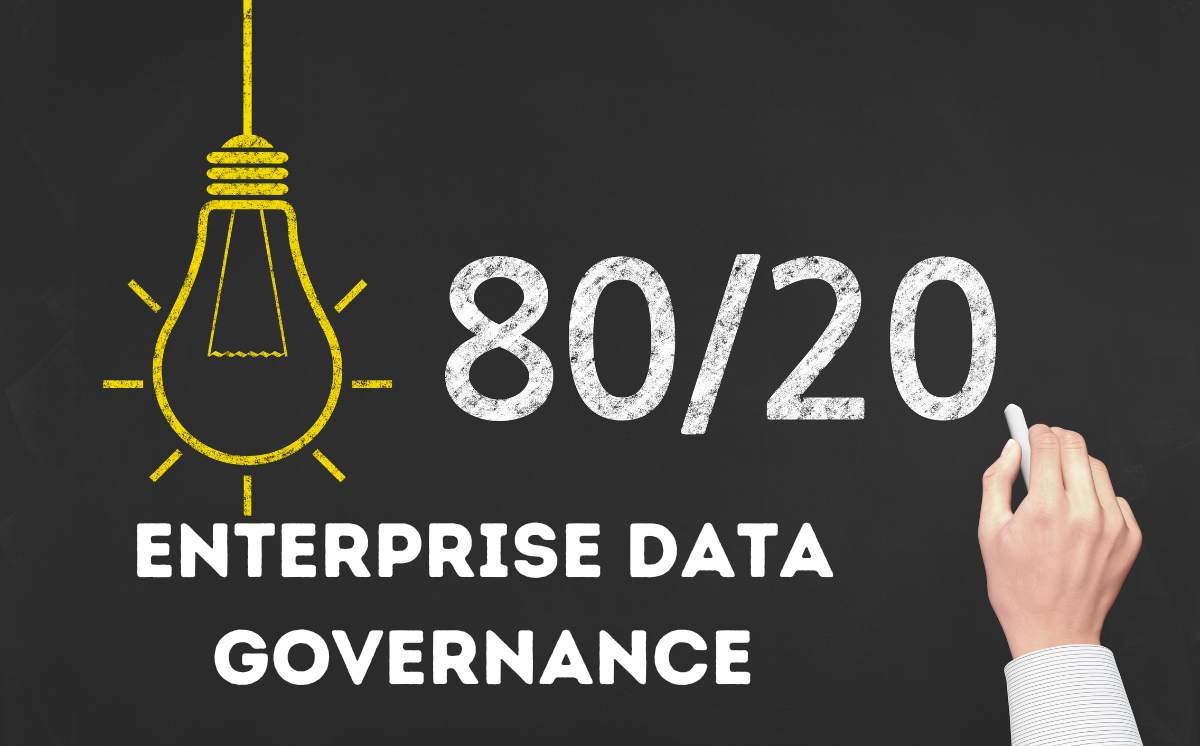Effective enterprise data governance is essential for organizations that rely on data to drive business decisions, support regulatory compliance, and manage risk. However, with enterprise data’s growing volume and complexity, prioritizing and managing data governance activities can take time and effort.
That’s where the 80/20 rule, also known as the Pareto principle, can be a valuable tool for focusing efforts on the most critical data assets.
In this blog post, we’ll explore how the 80/20 rule can be applied to enterprise data governance and provide some practical steps for organizations looking to implement this approach.
- What is the 80/20 rule?
- How can the 80/20 rule be applied to enterprise data governance?
- Here are some steps for applying the 80/20 rule to enterprise data governance:
- Step 1: Identify the 20% of critical data assets
- Step 2: Assess the quality and completeness of critical data assets
- Step 3: Prioritize critical data assets for governance activities
- Step 4: Allocate resources and budget to address critical data assets
- Step 5: Monitor and measure the effectiveness of data governance activities
- Here are some steps for applying the 80/20 rule to enterprise data governance:
- Benefits of applying the 80/20 rule to enterprise data governance
- Conclusion
What is the 80/20 rule?
The 80/20 rule is a principle named after Italian economist Vilfredo Pareto, who observed that roughly 80% of the effects come from 20% of the causes. For example, Pareto found that 80% of the wealth in Italy was owned by 20% of the population.
The 80/20 rule has since been applied to many other areas, including business management, where it’s often used to identify the most critical tasks, customers, or products that drive the majority of revenue or profits.
How can the 80/20 rule be applied to enterprise data governance?
When applied to enterprise data governance, the 80/20 rule can help organizations focus their efforts on the data assets most critical to their success while improving overall data quality and compliance.
Here are some steps for applying the 80/20 rule to enterprise data governance:
Step 1: Identify the 20% of critical data assets
The first step in applying the 80/20 rule to enterprise data governance is to identify the 20% of data assets that are most critical to the success of your organization. This may include data that drive key business processes, supports regulatory compliance, or contains sensitive information.
To identify these critical data assets, organizations should conduct a comprehensive inventory of their data and map it to key business processes, compliance requirements, and other critical functions. This will help identify the data assets most essential to the organization’s operations and success.
Step 2: Assess the quality and completeness of critical data assets
Once the critical data assets have been identified, the next step is to assess their quality and completeness. This involves determining whether the data is accurate, consistent, and up-to-date. It also involves identifying any gaps in the data that need to be filled.
To assess the quality and completeness of critical data assets, organizations should use data profiling and data quality tools to analyze the data and identify any issues. This will help ensure that the critical data assets are reliable and trustworthy.
Step 3: Prioritize critical data assets for governance activities
After assessing the quality and completeness of critical data assets, the next step is to prioritize them for governance activities based on their importance and risk.
This may involve implementing data quality controls, defining data ownership and stewardship, and establishing policies and procedures for data access and usage.
To prioritize critical data assets, organizations should develop a risk-based approach that considers the impact of the data on the organization’s operations and compliance requirements. This will help ensure that governance efforts focus on the most critical data assets.
Step 4: Allocate resources and budget to address critical data assets
Once the critical data assets have been prioritized, the next step is to allocate resources and budget to address them. This may involve investing in data management technologies, hiring additional staff, or providing training and education to existing personnel.
Organizations should develop a business case demonstrating the ROI of data governance activities to allocate resources and budget effectively. This will help ensure that resources are allocated to the most critical data assets and that the organization sees a return on its investment in data governance.
Step 5: Monitor and measure the effectiveness of data governance activities
The final step in applying the 80/20 rule to enterprise data governance is to monitor and measure the effectiveness of data governance activities continuously. This involves using metrics such as data quality scores, compliance rates, and user satisfaction to track progress and identify areas for improvement.
To monitor and measure the effectiveness of data governance activities, organizations should establish a governance framework that includes governance policies, procedures, and metrics.
This will help ensure that data governance activities are aligned with business objectives and that progress can be measured and reported on.
Benefits of applying the 80/20 rule to enterprise data governance
By applying the 80/20 rule to enterprise data governance, organizations can realize several benefits, including:
- Improved focus on critical data assets – By focusing efforts on the most critical data assets, organizations can ensure that they receive the appropriate attention and resources.
- Improved data quality – By assessing the quality and completeness of critical data assets and implementing data quality controls, organizations can improve the reliability and trustworthiness of their data.
- Improved compliance – Organizations can ensure they meet their regulatory compliance requirements by prioritizing critical data assets for governance activities and establishing policies and procedures for data access and usage.
- Better allocation of resources – By allocating resources and budget to address critical data assets, organizations can ensure that their data governance efforts focus on the areas that will have the greatest impact.
- Continuous improvement – By monitoring and measuring the effectiveness of data governance activities, organizations can identify areas for improvement and continuously improve their data governance processes.
Conclusion
Effective data governance is essential for organizations that rely on data to drive business decisions, support regulatory compliance, and manage risk. However, with enterprise data’s growing volume and complexity, prioritizing and managing data governance activities can be challenging.
Suppose you want to implement the 80/20 rule in your organization’s data governance efforts. In that case, it’s essential to start with a comprehensive data inventory and risk assessment and involve stakeholders from across the organization.
By taking a strategic and collaborative approach, you can ensure that your data governance efforts focus on the areas that will impact your organization’s success.







Leave a Reply